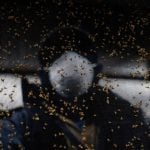Lush pastures might be high in energy and protein, but a mouthful of green grass usually does not meet the essential mineral and vitamin requirements of most post-calving beef cows.
Therefore, many producers might be compromising their cows’ reproductive performance. Many of these cows often fail to return to active estrus and fail to get rebred and finally become pregnant. Rather than go down this wrong road, producers should review their current mineral-vitamin program and choose one that drives successful reproduction.
Before I make any recommendation to producers as to what kind of mineral-vitamin feeding program is a good choice, most people should conduct a body assessment of each cow and calved-out heifer.
Read Also

Gentle treatments for pain in the neck
Heading toward year-end, people unknowingly tense up against the cold and busyness, causing neck pain that can often be treated with appropriate support and gentle mobility, athletic therapist Kathlyn Hossack says.
I advocate that all nursing animals should maintain a visible cow’s body condition score (BCS) of five to six (out of 10) by calving, which should be carried on to the end of the breeding season. Such adequate BCS has been research-proven to return a higher proportion of fertile beef cows compared to thin cows (BCS less than four) to active-strong estrus by 80 to 90 days postpartum. Strong estrus should result in highly successful conception rates.
Most mineral and vitamin requirements of even the best-bodied nursing cows and heifers soar as they return to active heat cycles in preparation for conception during a short 60-day breeding season. Postpartum cows’ calcium needs increase by nearly 100 per cent, while phosphorus, magnesium and trace mineral demands grow by 50-60 per cent, and the need for fat-soluble vitamins more than doubles.
For example, the requirement for manganese is about 400 milligrams per day per cow. Known to be involved in enzyme systems that drive follicular/egg development, a lack of dietary manganese is proven to lead to inactive estrus, or “silent heats.” Given that Canadian prairie grasses often contain less than 20 mg/kg manganese, the need for manganese supplementation in a typical cowherd diet is necessary.
In order to assure manganese and other essential mineral/vitamin requirements are achieved, I recommend a “breeder” cattle mineral be fed from calving and throughout the upcoming beef breeding season. Consequently, this type of special cattle mineral is a specific complement of macro-minerals (calcium, phosphorus, magnesium) as well as a high level of trace minerals in particular copper, zinc, manganese and selenium, fortified at the best concentrations as well as in highly bioavailable chelated forms. Once these macro- and trace minerals are consumed at three to four ounces per head daily, they are designed to reach the cows’ digestive tract, where they are quickly absorbed, efficiently metabolized and highly retained to build optimum mineral status.
I have met many producers who believe in feeding such a breeder cattle mineral after their calving season is done — but some of them modify it to tackle specific nutritional mineral issues such as “grass tetany” on lush pasture.
In these cases, this breeder mineral can be formulated with four to 12 per cent magnesium and fed during the high-risk period of the first two to three weeks of the grazing season. Other producers I’ve known have added extra copper to the same breeder mineral to combat secondary copper deficiencies caused by excessive amounts of copper-binding molybdenum found in their pasture grasses.
All such types of well-balanced cattle minerals/vitamins should be placed in proper mineral feeders and be accessible to all cows. The feeders should be protected from rain, wind, sunshine and sometimes defecating cows. I am the biggest fan of a two- or three-compartment durable heavy-duty plastic feeder with a fixed metal bar in the centre, which secures a weather-proof rubber flap.
The best ones have notches moulded into the base to bolt it down on top of a truck tire and keep it out of water and mud. Then, two bags of mineral and one bag of salt can be poured into the separate compartments and checked every few days to be cleaned and refilled.
A few springs ago, a friend of mine bought two brand-new blue mineral feeders with the black rubber flaps. He operates a 100-cow red Angus herd and routinely feeds a breeder mineral fortified with extra organic zinc in order to strengthen hooves of the cow herd by the breeding season.
The offbeat thing is that he used to feed this cattle mineral in the trunk of a wheel-less 1962 Oldsmobile found in his yard. He would put out three bags of mineral each week in this way until one day the cattle abruptly stopped eating it. That’s because a fox gave birth to her pups in the back and prevented cattle from sticking their heads in.
















